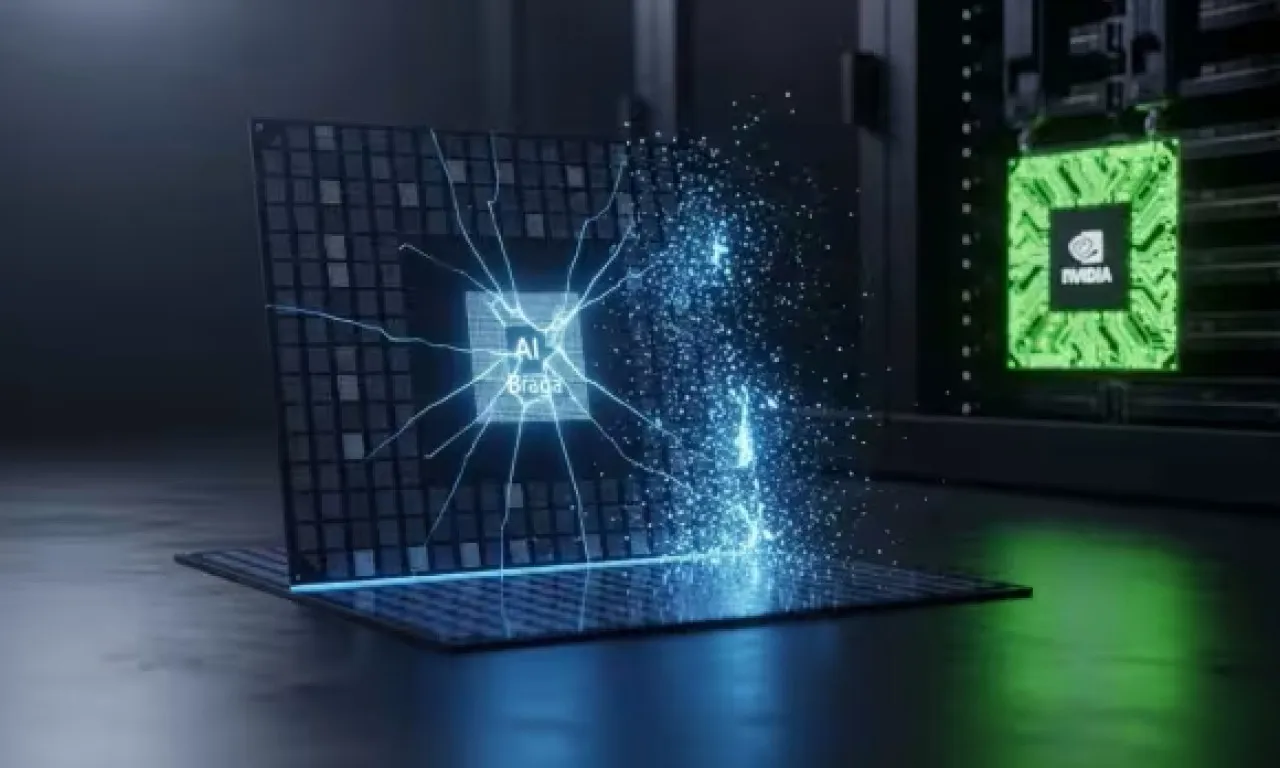The tech world is buzzing, and for a good reason. Microsoft’s shift to in-house chips is more than just a headline; it’s a seismic tremor disrupting the foundations of the semiconductor industry. For years, giants like NVIDIA and AMD have been the undisputed kings of the silicon kingdom, powering everything from gaming consoles to the most advanced AI data centers.
But the landscape is changing, and Microsoft is leading the charge, not with a whisper, but with a roar. By developing its own custom processors, the company is making a bold declaration of independence, aiming to create a more efficient, powerful, and cost-effective ecosystem for its massive cloud and AI ambitions.
This strategic pivot isn’t just about saving a few bucks on hardware. It’s a fundamental rethinking of how technology infrastructure is built from the ground up. Imagine building your dream house, but instead of buying materials from a hardware store, you own the forest, the quarry, and the factory.
You can design every single component to fit your exact specifications, ensuring perfect harmony and peak performance. That’s precisely what Microsoft is doing with its silicon. This move is poised to have a ripple effect across the entire industry, challenging the status quo and forcing competitors to rethink their own strategies. It’s a high-stakes game of innovation, and the outcome will define the future of computing for years to come.
Contents
- 1 1. Breaking Free: Reducing Dependence on NVIDIA and AMD
- 2 2. The Power of Customization: Tailor-Made for Performance
- 3 3. The Economic Equation: Driving Down Costs
- 4 4. A New Era of Innovation: Pushing the Technological Envelope
- 5 5. The Competitive Landscape: A Strategic Challenge to the Status Quo
- 6 6. Optimizing the Entire System: From Silicon to Service
- 7 7. The Future is Custom: Setting a Trend for the Industry
The Genesis of a Silicon Revolution
The decision for a company the size of Microsoft to venture into the notoriously complex and capital-intensive world of chip design wasn’t made overnight. It’s the culmination of years of planning, escalating costs, and the sheer, unadulterated demand for more computing power.
The AI boom, particularly the rise of large language models (LLMs) like those powering ChatGPT, has created an insatiable appetite for specialized processors. NVIDIA, with its formidable GPUs, became the go-to supplier, and its market dominance grew exponentially.
However, this reliance on a single primary supplier creates a significant bottleneck and a point of vulnerability. Supply chain disruptions, price hikes, and a one-size-fits-all approach to hardware can stifle innovation and inflate costs for cloud providers. Microsoft, a titan of the cloud with its Azure platform, felt these pressures acutely.
According to a report from Gurufocus, this strategic shift is a direct response to the need for greater control over its technological destiny. The company realized that to truly optimize its services, from Azure to Microsoft 365, it needed to control the entire stack, from the silicon to the software.
Unveiling the Titans: Maia 100 and Cobalt 100
At the heart of Microsoft’s shift to in-house chips are two groundbreaking pieces of custom silicon: the Azure Maia 100 AI Accelerator and the Azure Cobalt 100 CPU. These aren’t just mere clones of existing processors; they are purpose-built marvels of engineering, designed to excel at specific tasks within Microsoft’s vast data center ecosystem.
The Maia 100 is the AI powerhouse. It’s an accelerator specifically designed for AI tasks and generative AI, the kind of heavy lifting required to train and run massive LLMs. With a staggering 105 billion transistors, it’s engineered to handle these workloads with unprecedented efficiency. Microsoft even collaborated closely with OpenAI, ensuring that the chip was fine-tuned to power the very models that are redefining our interaction with technology.
On the other side of the spectrum is the Cobalt 100. This is an Arm-based processor tailored for general-purpose cloud services running on the Microsoft Cloud. Think of it as the workhorse, efficiently handling the millions of everyday tasks that keep Azure running smoothly. Its focus is on performance per watt, delivering greater efficiency and power savings, which, at the scale Microsoft operates, translates into substantial cost reductions and a smaller environmental footprint.
This dual-chip strategy is a masterstroke. It allows Microsoft to deploy the right tool for the right job, avoiding the compromises inherent in using general-purpose hardware for highly specialized tasks. It’s a targeted approach that promises to unlock new levels of performance and efficiency across its entire cloud infrastructure.
Read Also: Microsoft AI Chips: 3 Essential Truths About Their Exclusive New Strategy
1. Breaking Free: Reducing Dependence on NVIDIA and AMD
The most immediate and obvious driver behind Microsoft’s shift to in-house chips is the strategic imperative to reduce its reliance on third-party vendors, most notably NVIDIA and AMD. While these companies produce exceptional hardware, being at the mercy of their product roadmaps, pricing structures, and supply availability is a precarious position for a cloud giant.
By designing its own chips, Microsoft takes control of its supply chain. It can dictate the design, the manufacturing process, and the production volume, insulating itself from market volatility and potential shortages that could cripple its services.
This independence is not about completely severing ties but about creating a more balanced and resilient supply chain. Microsoft’s Chief Technology Officer, Kevin Scott, has emphasized that the company will continue to use chips from partners like NVIDIA where they make sense, but having a powerful in-house alternative provides crucial leverage and flexibility.
This move also introduces a new level of competition into the market, which is ultimately a good thing for consumers. When a customer as large as Microsoft becomes its own supplier, it forces existing chipmakers to innovate faster, be more competitive on pricing, and work more closely with their clients to meet specific needs. It’s a wake-up call that the era of unchallenged dominance in the AI chip market may be coming to a close.
2. The Power of Customization: Tailor-Made for Performance
One of the most compelling advantages of Microsoft’s shift to in-house chips is the ability to achieve a level of hardware-software co-design that is simply impossible with off-the-shelf components. Microsoft isn’t just designing a chip; it’s designing an entire system where every layer, from the silicon to the software running on it, is optimized to work in perfect harmony.
Think about the intricate dance between an operating system and a processor. When you control the design of both, you can build in efficiencies and capabilities that a general-purpose chip can’t match. The Maia 100, for instance, was developed with direct feedback from OpenAI. This collaboration allowed Microsoft’s engineers to understand the precise demands of training and running advanced AI models and to build a chip that excels at those specific workloads.
This deep integration extends beyond just the chip itself. Microsoft is re-imagining the entire data center stack, from custom server boards and racks to innovative liquid cooling solutions designed to handle the intense heat generated by these powerful processors. The result is a system that is greater than the sum of its parts—a finely tuned engine for cloud computing and AI that delivers superior performance, lower latency, and greater efficiency.
3. The Economic Equation: Driving Down Costs
Running data centers at the scale of Microsoft Azure is an incredibly expensive proposition. The cost of energy, cooling, and, of course, the hardware itself runs into the billions of dollars. Microsoft’s shift to in-house chips is a strategic move to gain significant control over these operational expenditures.
While the initial investment in chip design and manufacturing is astronomical, the long-term savings can be immense. By eliminating the profit margins of third-party vendors and optimizing chips for power efficiency, Microsoft can dramatically reduce the total cost of ownership (TCO) for its data center infrastructure. The Cobalt CPU, with its focus on performance per watt, is a prime example. Even a small improvement in energy efficiency, when multiplied across millions of servers, leads to massive savings in electricity costs.
Furthermore, by tailoring chips to specific needs, Microsoft can avoid paying for features or capabilities it doesn’t require, a common issue with general-purpose hardware. These cost savings can then be passed on to Azure customers in the form of more competitive pricing, or reinvested into further research and development, creating a virtuous cycle of innovation and value. It’s a long-term financial play that positions Microsoft for sustained profitability in the hyper-competitive cloud market.
4. A New Era of Innovation: Pushing the Technological Envelope
When you control the silicon, you control the pace of innovation. Microsoft’s shift to in-house chips allows the company to break free from the typical 18-to-24-month product cycles of traditional chipmakers. If a new idea or a breakthrough in architecture emerges, Microsoft’s engineers can integrate it into their next-generation designs much more rapidly.
This agility is a powerful competitive advantage. It allows Microsoft to respond quickly to new trends in AI and cloud computing, ensuring its infrastructure remains at the cutting edge. We’re already seeing this with the company’s work on advanced cooling systems. The intense power density of chips like Maia 100 requires new ways to dissipate heat. In response, Microsoft is pioneering novel liquid cooling technologies that are co-designed with the chips themselves, enabling higher performance without the risk of overheating.
This vertical integration fosters a culture of holistic innovation. The teams working on the Cobalt CPU are in constant communication with the teams developing the Azure services that will run on it. This feedback loop allows for continuous improvement and the creation of features that are deeply integrated and highly optimized. It’s about building the future of the cloud, not just buying it off the shelf.
5. The Competitive Landscape: A Strategic Challenge to the Status Quo
Let’s be clear: Microsoft’s shift to in-house chips is a direct challenge to the established order of the semiconductor industry. It’s a move that has sent ripples through the boardrooms of NVIDIA, AMD, and Intel. For decades, these companies have operated on a model where they design powerful, general-purpose chips for a broad market. Now, their biggest customers are becoming their biggest competitors.
Microsoft is not alone in this endeavor. Other cloud giants like Amazon with its Graviton and Trainium chips, and Google with its Tensor Processing Units (TPUs), are on the same path. This trend of hyperscalers bringing chip design in-house represents the single greatest strategic threat to the traditional semiconductor business model.
This doesn’t mean NVIDIA and AMD are going to disappear overnight. Their technology is still best-in-class for many applications, and they have a massive head start in terms of software ecosystems and developer support. However, they can no longer take their largest customers for granted. They will need to adapt, perhaps by offering more semi-custom solutions or by focusing on areas where their general-purpose architectures still hold a significant advantage. The game has changed, and the pressure is on.
6. Optimizing the Entire System: From Silicon to Service
The true genius of Microsoft’s shift to in-house chips lies in its systems-level approach. The company understands that peak performance isn’t just about having the fastest processor. It’s about optimizing the entire chain, from the transistors on the silicon to the network that connects the servers, the cooling that keeps them running, and the software that delivers the service to the end-user.
Microsoft’s CTO, Kevin Scott, has repeatedly spoken about this holistic view. The goal is to “co-design and co-optimize every layer of the stack.” The custom racks built for the Maia 100 servers are wider than standard racks to accommodate the unique cooling and networking requirements. The networking protocols are designed to facilitate the massive data transfers required for training large AI models.
This level of vertical integration allows Microsoft to eke out every last drop of performance and efficiency. It can eliminate bottlenecks that would be invisible or impossible to solve when piecing together components from different vendors. This systemic optimization is a powerful, long-term advantage that will be difficult for competitors to replicate. It ensures that Microsoft’s cloud services are not just running on powerful hardware, but on a perfectly orchestrated and harmonious system.
7. The Future is Custom: Setting a Trend for the Industry
The move by Microsoft, Google, and Amazon is more than just an internal strategy; it’s a bellwether for the future of the technology industry. As computing workloads become increasingly specialized—driven by the demands of AI, machine learning, and massive data analytics—the case for custom silicon becomes ever more compelling.
We are moving away from a world dominated by a few general-purpose processor architectures and toward a future characterized by a diverse ecosystem of specialized chips, each designed to perform a specific set of tasks with maximum efficiency. Microsoft’s shift to in-house chips is a leading indicator of this broader industry trend.
This shift will have profound implications. It will create new opportunities for chip design firms, foundries, and the entire semiconductor supply chain. It will also force software developers to think differently, writing code that can take advantage of these new, specialized architectures. For customers, it promises a future of more powerful, more efficient, and more affordable cloud services, tailored to their specific needs. Microsoft isn’t just building chips for itself; it’s lighting the path toward a new, more customized era of computing. The age of custom silicon is here, and Microsoft is firmly in the driver’s seat.




